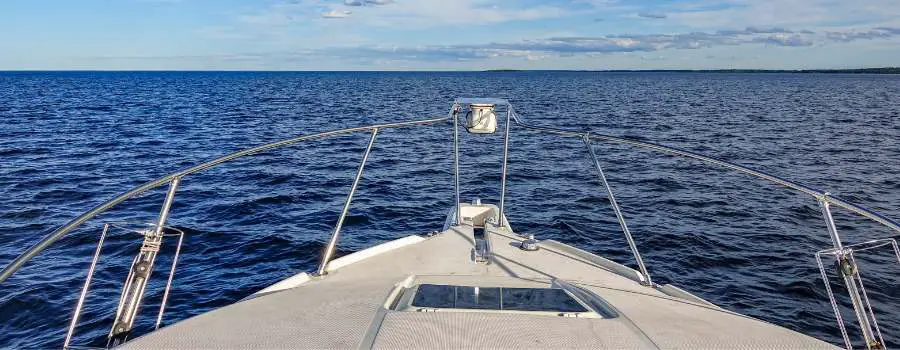For those who aren’t familiar with solar power, the advancements in solar panels are improving year over year, with a .05% increase in capacity each year. Most people assume that a solar panel or two would provide a trickle-down charge.
Depending on the solar panel and the Marine Battery (12-volt deep cycle batteries most of the time), a solar panel should be more than capable of charging up your battery. Of course, there is a difference between a battery you might use on a kayak and one on a yacht.
Size matters when it comes to charging a marine battery or an RV battery. For instance, a 20-watt solar panel just isn’t going to have the juice to provide anything more than a trickle charge for your battery.

What Solar Panels Are Best For Marine Batteries?
If you want solar panels that are going to actually charge your marine batteries rather than just maintain them, you need something that is 100 watts or higher and it needs to have a solid conversion rate.
A 20% conversion rate on a 100-watt solar panel will charge a marine battery in under 8 hours. With that knowledge in your head, you can start to formulate a game plan if, say, you have had two or three deep cycle batteries on board, in addition to a cranking battery.
Once you drop below 100 watts, to something like 70 watts, you’re pushing back into maintenance territory. That’s still a good solar panel but you shouldn’t expect it to charge your marine batteries, especially if it’s cloudy or its wintertime and the days are a lot shorter.
Series Batteries
Most of the time, when anglers or boaters have a bunch of 12-volt batteries, they set them up in a series. All this does is present you with a math problem. Two 12-volt batteries in a series are essentially 24-volt batteries.
Now, you know that a 100-watt solar panel with a 20% conversion rate will effectively charge a 12-volt battery in about 8 hours. So, you’re looking at two, 100-watt solar panels with 20% conversion rates to keep up.
The problem is, it’s a lot easier to stow batteries away on a boat than it is to mount 100-watt solar panels all over the place.
Type of Solar Panel
Mono-crystalline solar panels (c-Si) are the oldest in solar panel technology but, surprisingly, they are still the most powerful, taking in the most energy from direct sunlight. If you’re looking for something that will charge a large series of batteries, mono-crystalline solar panels are the best.
Each cell in a mono-crystalline solar panel generates about 16 volts. The other type of solar pane is the Amorphous Thin Film Silicone (a-Si). Despite the long and interesting name, these solar panels are only about half as efficient as c-Si panels.
These are the kind of panels you want if you’re going to string some LED Christmas lights across your kayak. They are definitely not going to power a series of deep-cycle batteries. Maybe if you covered the entire boat with them, including your viewports but still unlikely.
Panel Positioning
You would be surprised at how much this matters. Being out on open water is no different than being out in the desert. There is no shade. The only shade provided comes from whatever is on your boat and those shadows shift as the boat turns or the sun moves across the sky.
If you have your solar panels mounted in such a way that a portion of the boat throws shade over them, the effect on that solar panel’s capabilities is severely diminished until that shade moves away.
As we mentioned above, there is a multitude of individual panels inside of a solar panel. These panels (or cells) or rendered useless during the timeframe when a shadow is resting on them.
Cold and Hot
While you can’t control the weather, solar panels perform better on cooler days than they do on hotter days. In fact, solar panels exceed factory expectations by up to 35% in the winter. If you live next to the Great Lakes, that’s awesome. If you dock off of Lake Okeechobee, that’s a setback.
Since there is not much you can do about keeping solar panels mounted on your boat cool, during the summer months that is, you just need to understand that they may underperform throughout the hot months.
How To Get The Best Charging Power Out Of Your Solar Panels
The first thing you need to do is find the right solar panels. They aren’t cheap and if you go cheap, your options are going to be ‘waste of time’ and ‘Amorphous Thin Film Silicone,’ neither of which will do the trick.
While a 100-watt solar panel will charge your battery in 8 hours, it’s better to go with something higher, such as a 300-watt panel. Choose carefully how and where you install the solar panel in its permanent position.
You don’t want to discover that any time you face from northeast to northwest, you are losing 25% to 30% of your solar generation because it’s sitting in shadows cast by your own boat. The trick is to mount your solar panel so it will remain perpendicular to the sun as much as possible.
If you can mount it in such a way that it’s mobile, at least to a degree, that’s even better. Even the smallest shadow can seriously rob the effectiveness of a single solar panel until you move out of the shadow. Last but not least, endeavor to keep your solar panels cool.
While you can’t do anything about the summer weather, you can ensure that there is ventilation beneath the solar panel. All of these things will help you charge those marine batteries faster at the end of the day.
